#Diana Sacayán
Explore tagged Tumblr posts
Text
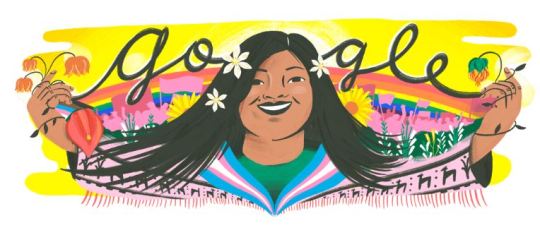
Today’s Doodle honors Indigenous Argentine human rights activist Amancay Diana Sacayán. On this day in 2012, Sacayán became the first Argentine trans woman to receive a national identity card affirming her gender. The Doodle artwork, illustrated by Buenos Aires-based guest artist Juan Dellacha, depicts Sacayán as a joyful activist whose persistence, in spite of all the violence she suffered throughout her whole life, left a huge legacy. A proud descendant of the Diaguita people, Sacayán was born in Tucumán, Argentina, on December 31, 1975. She and her 15 siblings moved to Buenos Aires, where she would spend most of her life. Sacayán enjoyed school until she was expelled as a result of coming out as transgender. She faced police persecution quickly and was arrested multiple times for her clothing choice and trans identity. Sacayán fought tirelessly for LGBTQ+ rights during her life. She was involved with many activist groups, notably a member of the National Front for the Gender Identity Law and a leader of the International Lesbian, Gay, and Bisexual Association. She founded the Movimiento Antidiscriminatorio de Liberación (Anti-Discriminatory Liberation Movement), which was dedicated to improving human rights for the queer community, focusing on inclusion within schools, workplaces, and hospitals. Today, because of her activism, trans people can have their name and gender respected when they access health care. 1% of public sector employees in Buenos Aires are in the trans community, thanks to the Trans Labor Quota Law that Sacayán promoted. This law was expanded to the national level in 2020, but tragically, Sacayán was not around to see it. She was killed in a hate crime in 2015, and her murderer is considered the first person in Argentina to be convicted of a hate crime against the trans community. Her resilience and accomplishments continue to inspire. She persuaded the public sector to include trans people, advocated for hospitals to use people's correct names, and set an example by being the first legally recognized trans person in her country. Thank you for dedicating your life to vastly improve trans rights, Amancay Diana Sacayán.
Source | Art by Juan Dellacha
I am thrilled beyond words to see Diana Sacayán in a doodle. Witnessing her wisdom, kindness and activism was an honor and a privilege and she is missed every day. The artist also said something about her legacy that isn't mentioned enough: "Diana believed that the fight for LGBT+ rights also needed to have social, environmental, native and class consciousness too. It couldn’t be one without the other. I deeply agree with that and I think it’s very important to have that in mind, especially in the times we are living in." She truly lives on in the battles won and in the ones yet to win but the way in which she was taken so soon should not be forgotten.
#diana sacayán#amancay diana sacayán#diana sacayan#i have a drawing i made of her in a notebook i am so thrilled to see her here#argentina#trans rights
330 notes
·
View notes
Text
There a lot of queer icons in Argentina but my favs one as a trans person that also identifies as transvestite is Lohanna Berkins, feminist and trans activist and Diana Sacayán, trans and indigenous activist (her murder also was the first one in being fairly judged in the justice.)
They both were big warriors for social justice to any marginalized group, i love them so much.
I would actually love to hear more about more local queer symbols! Ideally from the queer community outside of North America, please share some queer symbols that are specific to your region!
#Lohanna Berkins#Diana Sacayán#In general our older trans ppl is iconic#Thanks to them we have the best trans law in the world#They deserve everything#Argentina
358 notes
·
View notes
Text
actually MY gay liberation is diana sacayán and lohana berkins, carlos and roberto jáuregui, maría elena walsh, virus playing sin disfraz, sandra and celeste singing puerto pollensa and Nuestro Mundo being the first lgbt movement in argentina and latinoamérica
234 notes
·
View notes
Text
Recién me di cuenta de que me estaba siguiendo una TERF. Me parece que voy a tener que aclarar que soy soldado de Lohana Berkins y Diana Sacayán y que ninguna trans-travesti odiante es mi "hermana". Así que si sos una TERF rajá de acá ❤️
28 notes
·
View notes
Photo
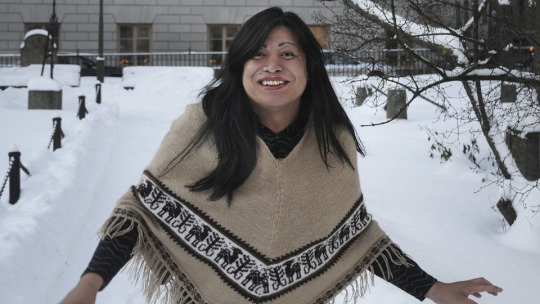
Diana Sacayán (deceased)
Gender: Transgender woman
Sexuality: N/A
DOB: 31 December 1975
RIP: 11 October 2015
Ethnicity: Indigenous Argentinian (Diaguita)
Occupation: Lawyer, activist
Note: Her murder led to nationwide condemnation and the creation of the legal precedent of “travesticidio” in Argentine law, an aggravated form of hate crime which led to life imprisonment for her murderer.
#Diana Sacayán#Diana Sacayan#lgbt history#bipoc#lgbt#transgender#transgender woman#1975#rip#historical#native#Indigenous#hispanic#poc#lawyer#activist#popular#popular post
234 notes
·
View notes
Text
Crónica del Orgullo Gay
Diana Sacayán — Piquetera y Travesti

1 note
·
View note
Photo




Amancay Diana Sacayán, a diaguita descendant, was an Argentinean trans woman from Tucumán, recognised as one of the major activist of the human rights movement (including the Ni Una Menos and the legalization of abortion feminist movements) and the social recognition and inclusion of trans people in Argentina and South America. She was murdered on October 11th, 2015. On June 18th, 2018, the Tribunal Oral Criminal Nro. 4 of Buenos Aires City convicted her murderer with a historic sentence. It was the first time the Argentine justice system qualified the murder of a trans person as a hate crime against gender identity.
[Featured art by Flor Capella.]
2K notes
·
View notes
Note
hola, espero que esta pregunta no te moleste, es que vi tu último reblog y quería saber si sabes un poco sobre la historia de la comunidad lgbt en argentina o si existe alguna fuente confiable donde aprender? la verdad es que mucha gente lgbt de acá siempre comparte sobre lo que pasó y pasa en gringolandia pero jamás se habla de la historia de acá, se que tranquilamente podría googlearlo pero a veces respondes cosas interesantes :(
Hola! Si obvio, me encanta jajajaj, me parece super dulce que preguntes. Espero que no te moleste que responda en inglés.
A little bit of Argentine LGBT History on this Pride month...
First of all, here in Argentina we celebrate Pride in November, to commemorate the forming of the first LGBT+ organization in both Argentina and Latin America, back in 1967, called Nuestro Mundo. As soon as democracy was restored after the dictatorship (1983), Carlos Jauregui and Cesar Cigiutti formed Comunidad Homosexual Argentina, one of the organizations that pushed and organized towards our first Pride march in 1992.
I mention Jauregui specifically because he's one of our most well known gay activists, he even has a metro station named after him in the City of Buenos Aires. He fought for the community's visibility and rights tirelessly. There's a movie on his life, you can watch it for free here (only in Spanish though)
Argentina also became the first Latin American country and 10th in the world to legalise same sex marriage in 2010.
In 2012, the Gender Identity Law was passed, allowing people to be treated according to their gender identity and have their personal documents registered with the corresponding name and gender. In addition, it orders that all medical treatments for transitioning be included in the Compulsory Medical Program, which guarantees coverage by practices throughout the health system, both public and private.
This law has been lauded as some of the most progressive gender legislation in the world, as people can now alter their gender on official documents without first having to receive a psychiatric diagnosis or surgery.
This, obviously, doesn't mean that the trans' community's problems were solved. Today, trans people's life expectancy in Argentina is between 35-40 years, they are an extremely vulnerable and marginalized group. So, there is much work to be done. We have a rich transgender history here, and it is being preserved in the Archivo de la Memoria Trans, documenting trans women's lives. It's wonderful, please do check them out and give them a follow.
Although there are many, many wonderful trans activists here like Susy Shock and Diana Sacayán, here I want to highlight Lohana Berkins. She was a proud travesti* activist who fought her entire life for the rights of trans and travesti people.
"The love that we were denied is our impulse for change" - Lohana

(Pictured: Carlos Jauregui and Lohana Berkins)
* Travesti is a term used in Latin America, it's a gender identity that disrupts the gender binary. "Travestism disrupts this gender binary according to which, in western societies, is hegemonic and oppresses those who resist being submitted into the "male" and "female" categories" (In Spanish. Recomiendo leer este artículo)
I'm afraid I only have resources in Spanish, so. Got a few documentaries:
Mocha Celis, el primer bachillerato trans travesti del mundo. (Gratis, hay que registrarse nada más)
Entrevistas a Lohana Berkins. x | x
Furia Travesti, una cooperativa textil trans.
Por qué no se habla de persecución a LGBT+ en dictadura
552 notes
·
View notes
Text
Así se vivió el 8M 2023: un mapeo de imágenes, reclamos y consignas en América Latina
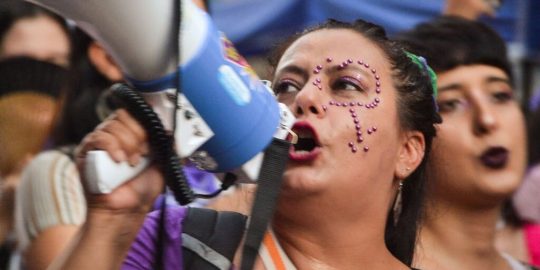
Estuvimos en las calles de Asunción, Buenos Aires, Ciudad de Mexico y San Salvador. Lo que vimos, escuchamos, gritamos, reporteamos y nos llamó la atención este 8M 2023. Miles de mujeres, lesbianas, travestis, trans, bisexualas, femeneidades y diversidades indígenas, trabajadoras, migrantas, participaron de las movilizaciones por el 8M en distintas localidades de la Argentina. En Buenos Aires hubo dos marchas, una hacia Plaza de Mayo y otra hacia el Congreso de la Nación. Todas partieron de 9 de julio y avenida de Mayo. En la tarde resonaron múltiples reclamos sociales, políticos y culturales. Desde el cese de las violencias hasta el reconocimiento de las identidades indígenas y la reparación a las mujeres trans y travestis. “Hoy marchamos para que esta sociedad y el Estado reconozcan que la condición a la sometió a la población travesti trans es de genocidio y debe repararnos y darnos garantías de no repetición para nuestras niñas y niños y defenderlxs del odio externo” dijo Marlene Wayar, en la columna travesti trans Diana Sacayán. Allí los carteles enumeraban los reclamos: Reparación histórica, indemnización por persecución, cupo laboral travesti trans y también la pregunta que sigue vigente a poco de cumplirse otro aniversario de la desaparición del joven trans: Dónde está Tehuel? La activista Florencia Guimaraes resaltó: “Seguimos exigiendo la urgente implementación del cupo laboral travesti trans y la ley de reparación histórica. Es una deuda del Estado con las compañeras travestis y trans perseguidas y torturadas simplemente por su identidad de género. Hemos atravesado muchos años pidiendo esto, muchas compañeras no están y otras se están muriendo. ¡El tiempo de la reparación es ahora!”. Mujeres y diversidades indígenas ocuparon un espacio crucial en este 8M. Pidieron por igualdad, basta de genocidio y persecusión, basta de terricidio. También la urgente libertad a las presas políticas mapuche que continúan privadas de su libertad desde octubre de 2023. Campesinas e indígenas peruanas participaron con carteles denunciando las violaciones de ddhh en su país.
8M en Asunción
Mujeres de distintas organizaciones sociales, políticas, del campo y de la ciudad se congregaron en el microcentro de Asunción y marcharon por el #8MPy. Este año, la articulación Paro de Mujeres Paraguay escogió el lema “Por nuestros derechos laborales y contra todas las violencias” por el actual contexto del país que se encuentra marcado por una ola de feminicidios, acosos y discriminaciones. “Queremos vivir y no sobrevivir”, “Marcho hoy con mis amigas para no marchar mañana por ellas“Los derechos de las personas trans son derechos humanos”, “Basta de acoso sexual y laboral”, “Qué ganas de ser pared para que te indignes si me tocan sin permiso” fueron algunos de los carteles que denunciaban la situación de las mujeres en el país. La marea violeta marchó con brillo, sudor y éxtasis por las calles Mariscal Estigarribia, Palma e Independencia desde la plaza Uruguaya hasta la plaza de la Democracia. Este año, el manifiesto hizo hincapié en la precarización de las mujeres trabajadoras en el año electoral. “Les decimos firmemente: ¡No van a comprar nuestro futuro con un 100mil!”, sostuvieron, refiriéndose al prebendarismo político. Exigieron políticas públicas para la disminución de los empleos informales y contra la precarización laboral. Así como seguridad social, igual paga por igual trabajo, seguridad laboral y protocolos contra todo tipo de violencia. Hasta el 8 de marzo se registraron 11 feminicidios en Paraguay y 2 víctimas de feminicidio en Argentina (se toma en cuenta a las paraguayas migrantes), una cifra que supera más de tres veces la cifra del año pasado en el mismo periodo. La articulación denunció la desprotección a las mujeres en situaciones de violencia y exigió el cumplimiento de la ley 5777/16 integral contra la violencia hacia las mujeres.

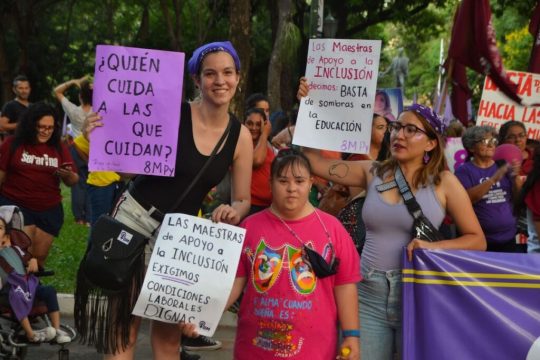
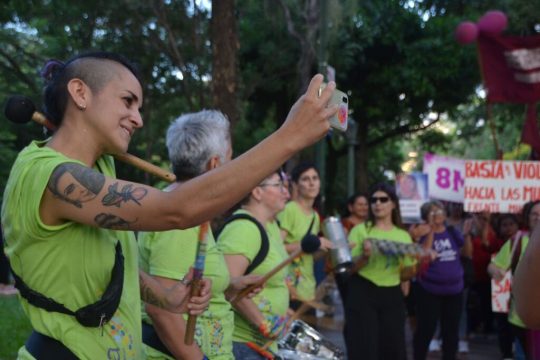

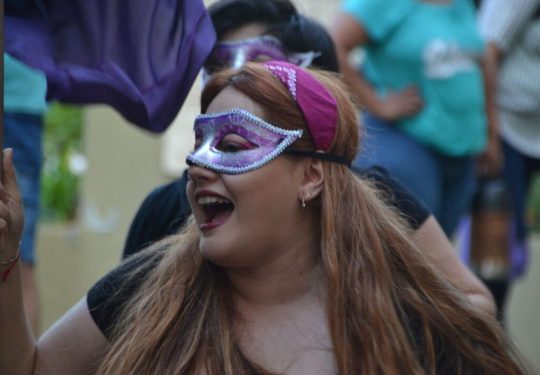
8M en San Salvador
En San Salvador cientos de mujeres salieron a las calles para exigir a la Asamblea Legislativa legislar sobre la ley de identidad de género, acceso al aborto, liberación de miles de personas detenidas arbitrariamente y justicia por los feminicidios.

8M en Ciudad de México Este 8M en la Ciudad de México contingentes de madres y padres de víctimas de feminicidio y desaparición, contra la militarización, el racismo, la violencia vicaria y la violencia ácida así como estudiantes, médicas, músicas, mujeres indígenas, mujeres discapacitadas, cannábicas, vagoneras, negras, cimarronas, bordadoras, niñas, adolescentes, adultas mayores, mujeres trans, lesbianas, bisexuales, personas no binarias y más tomaron las calles de la Ciudad de México. Exigieron justicia, seguridad, memoria, despenalización del aborto y que se garantice el derecho a una vida libre de violencias en un país donde 10 mujeres son asesinadas diariamente.

Fue una marcha multitudinaria. De acuerdo a datos del gobierno de la CDMX, asistieron 90 mil personas, superando a la de 2020 donde asistieron 75 mil personas.
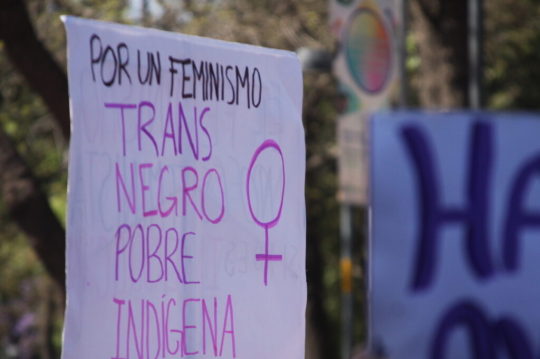
Partió de distintos puntos de la ciudad. Del Ángel de la Independencia, el Monumento a la Revolución y la Glorieta de las Mujeres que Luchan, todas con dirección a El Zócalo. Durante el recorrido sobresalieron la cantidad de carteles con consignas contra la violencia machista y patriarcal.
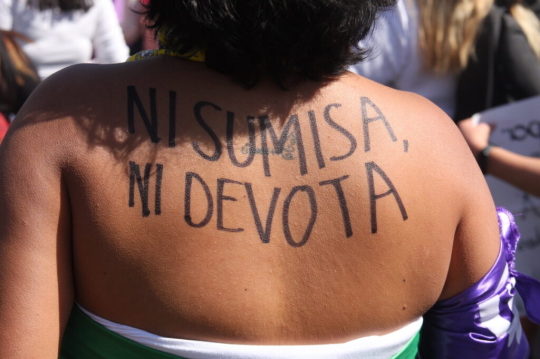
Hubo distintas expresiones artísticas: bordados, danza y música de instrumentos de viento, jaranas, percusiones. También hubo rap y sonidero por parte de ChingonaSound frente a la Antimonumenta.
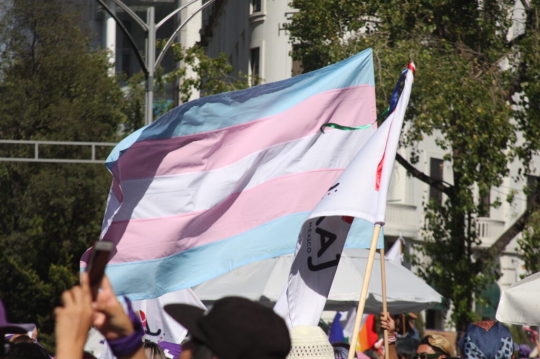
Grupos que convocaron y se expresaron como transincluyentes izaron banderas trans, LGBT+, y gritaron consignas de la resistencia trans. También asistieron familiares de Ximena, una mujer trans de 28 años asesinada este año en Teotihuacán.
Ataques de transodio y violencia policial
Durante el recorrido se podían leer pintas transodiantes. Una reportera del medio La Lista documentó el momento en que Mikaelah y Marian, dos mujeres trans racializadas, activistas e integrantes de la escena ballroom, fueron atacadas por un grupo de mujeres durante la marcha. Las insultaron, malgenerizaron y lanzaron aerosol.

Previo al arranque y durante la marcha se suscitaron algunos encapsulamientos policiales. El Frente por libertad de Expresión y Protesta documentó el uso excesivo de polvo de extintor, gas irritante y lanzamiento de piedras por parte de la policía. También recuperaron cartuchos de gas lacrimógeno lanzado en forma de cohetón. Identificaron el uso de balines de metal que provenían de las vallas de protección de los cuerpos policiales. Y otras malas prácticas como que la policía no estaba identificada, vestían de civil y tomaron fotografías a las manifestantes. La marcha que arrancó desde la una de la tarde terminó en la plancha del Zócalo hasta pasadas las siete de la noche. :::Agencia Presentes::: Read the full article
3 notes
·
View notes
Photo
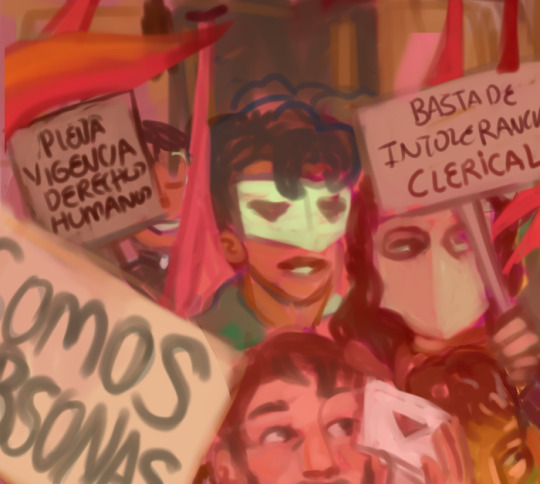
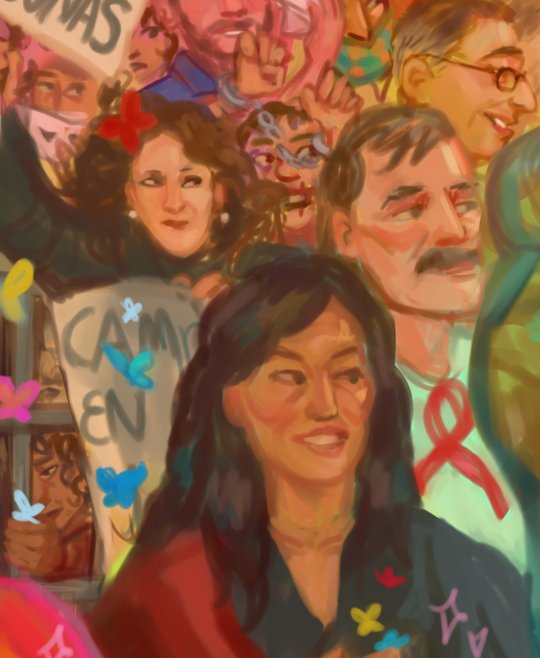
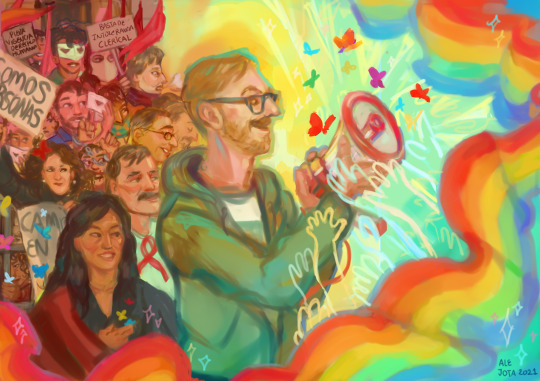
Horizontes
A commissioned piece for Casa Brandon as a homage to Carlos Jáuregui. It’s difficult to sum up in a single painting all LGTB+ history between the 70s and the 90s and all the demands made by the community, so i gave my best shot in a very short deadline.
There are familiar faces, like Cesar Cigliutti, Diana Sacayán, Ilse Fuskova, Roberto Jáuregui, Karina Urbino, and anonymous ones. I tried to give space for the future, too. After a decade of new rights, we are uncertain about who will be the the protagonists, the voices that need to be heard, and the possibilities of the movement in the years to come. But it’s necessary to keep memory alive, to keep this struggle alive, never forget, and keep passing the mic.
We have a very rich queer history down here in Argentina, I recommend watching El Puto Inolvidable and the Trans Memory Archive
114 notes
·
View notes
Text
Argentina
After more than two hours of debate with emotional speeches, the Senate almost unanimously signed into law the bill that creates a 1% job quota for trans people in the public sector. It also provides incentives for hiring trans people in the private sector and preferential credit lines for their ventures.
The Diana Sacayán - Lohana Berkins Law was named after the already deceased activists for trans workers rights.
(Check out the full article if you speak Spanish!)
109 notes
·
View notes
Text
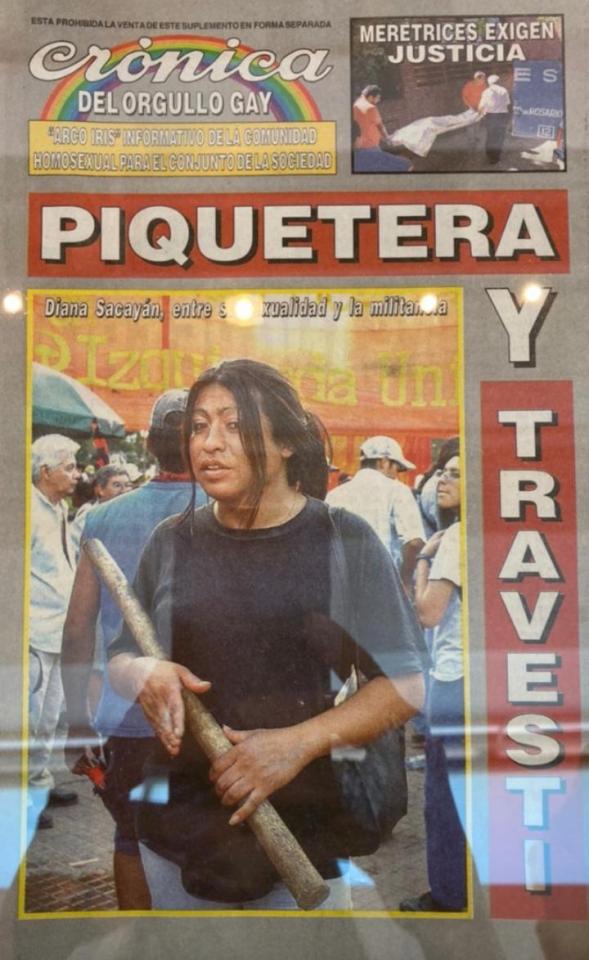
Crónica del Orgullo Gay : "Arco Iris" Informativo de la Comunidad Homosexual para el Conjunto de la Sociedad
[30/1/2004] Piquetera y travesti. Diana Sacayán entre su sexualidad y la militancia
#Diana Sacayan#travesti#transgender#transsexual#lgbttt#lgbtq#queer history#lgbt history#argentina#historic archive#latinamerica#archivo#archivo historico#latinoamerica
2 notes
·
View notes
Text
Hoy sucedió algo historico y lo tengo que escribir porque paso de verdad, hoy 24 de junio del 2021 se aprobó en el senado la Ley de cupo laboral travesti-trans ‘Diana Sacayán-Lohana Berkins’ nombres de reconocidas activistas del colectivo.
La ley estipula que el Estado nacional deberá garantizar un mínimo del 1 por ciento de su planta laboral para personas travestis, transexuales y transgénero. Además, tendrá que cumplir una serie de obligaciones de no discriminación en el acceso a los puestos de trabajo y habrá incentivos económicos para contrataciones en el sector privado.
Esta ley es un avance más en el reconocimiento de los derechos de las personas trans y resultado de la enorme lucha que vienen trayendo y accionando. Hace nueve años se sancionó la Ley de identidad de género 26.743 y hoy la ley de cupo laboral trans. Vos entendes que esto es un avance enorme como sociedad y como pais, no? APLAUSOS CARAJO.
Acá el proyecto de ley

28 notes
·
View notes
Text

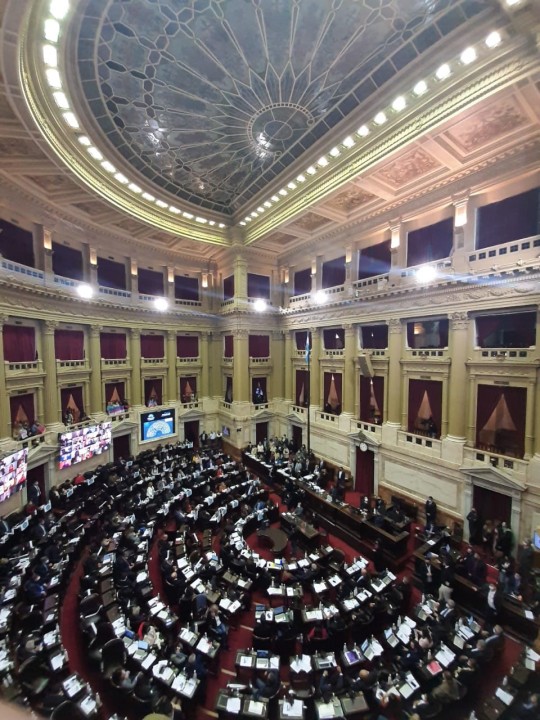

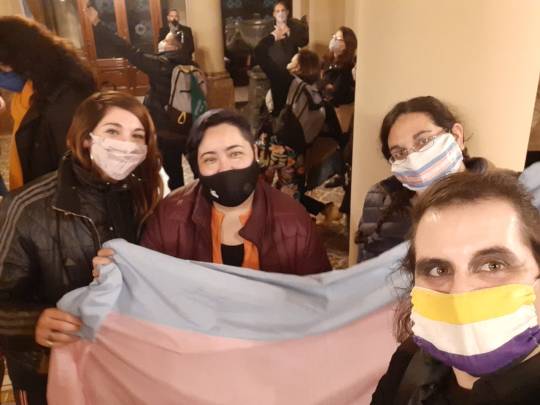


El proyecto de ley de cupo e inclusión laboral travesti–trans...
obtuvo media sanción por amplia mayoría en la Cámara de Diputados de la Nación Argentina.
Además de fijar un mínimo del 1 por ciento para todo el personal del Estado nacional, el proyecto que lleva el nombre de Diana Sacayán y Loahana Berkins, dos históricas militantes del colectivo travesti-trans, prevé incentivos por contratación para las empresas privadas y establece una serie de obligaciones del Estado para garantizar el acceso al empleo de una población históricamente oprimida.
El proyecto de ley del cupo laboral travesti trans obtuvo media sanción con 207 votos a favor. Ahora falta que se vote en el Senado. El resultado fue muy esperanzador. Muchos discursos conmovedores y otros que les faltó asesoramiento/conocimiento, sin embargo es una alegría.

#Siendo Humanes#comunidad lgbt#Latinoamerica lgbt+#Argentina#lgbt+ family#lgtbqplus#shareyourpride#Trans#nonbinary
15 notes
·
View notes
Photo

Amancay Diana Sacayán was well respected in her home country for her work with LGBT rights group Movimento Antidiscriminatorio de Liberación and role as an alternate representative of the Trans Secretariat on the Board of ILGA (International Lesbian, Gay, Bisexual, Trans and Intersex Association).In 2012 she was one of the first transgender citizens to change their legal gender and was issued legal papers directly by Argentina’s president Cristina Kirchner.
October 11, 2015, in Buenos Aires, Argentina
We will not be silenced. We must fight back against transphobia. For Amancay.
3 notes
·
View notes
Photo

Diana Sacayán - ‘ Somos sujetas de derecho’
1 note
·
View note